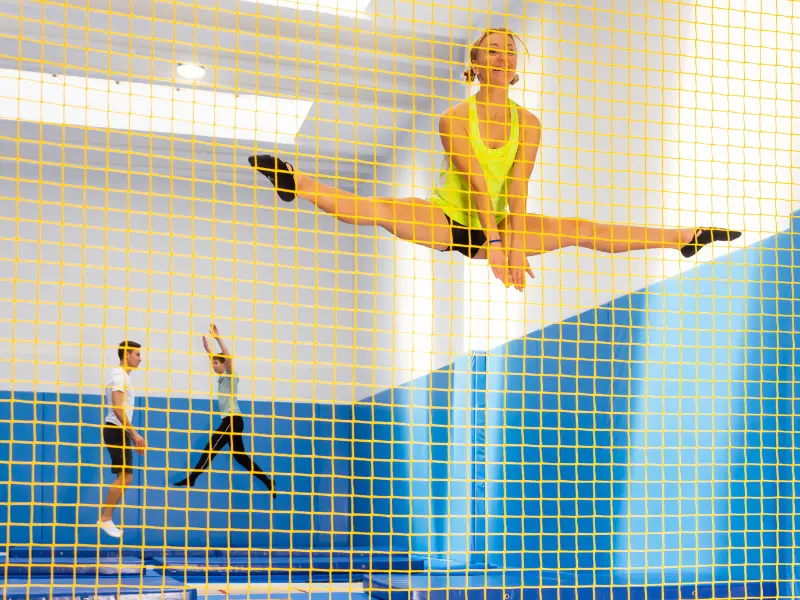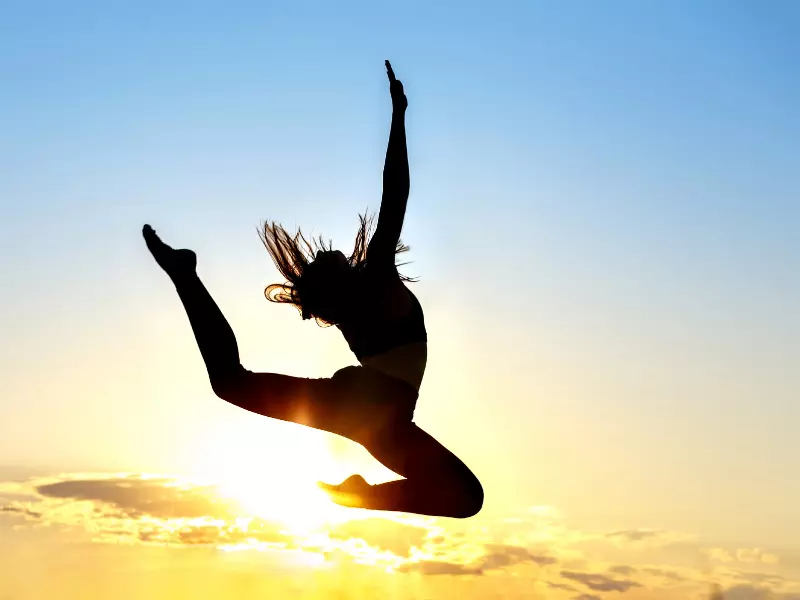Gymnasts are some of the most physically fit athletes in the world. They are strong, flexible, and have amazing control over their bodies. Do you ever wonder why gymnasts have such big thighs? You’re not alone. Many people have trouble understanding how these athletes got their bodies. The truth is, they didn’t do it overnight. It takes hard work, dedication, and the right training regimen. And while you may not be able to achieve the same level of success as a gymnast, you can still improve your own legs with the right exercises.
Contents
What Leg Muscles Do Gymnasts Use?
Gymnasts engage in intense physical activity that requires great strength, agility, and flexibility. While all of these attributes are important, the ability to generate powerful thrusts with the legs is essential for many of the sport’s key movements. So it’s no surprise that gymnasts have big thighs.
The primary muscles used by gymnasts in their leg movements are the quadriceps and hamstrings. The quadriceps are located at the front of the thigh and are responsible for extending the knee. The hamstrings are located at the back of the thigh and are responsible for flexing the knee.
Both of these muscle groups are engaged when a gymnast performs a tumbling pass or dismounts from a piece of equipment.
The Science Of Why Gymnasts Have Big Thighs
Gymnasts are some of the most physically fit athletes in the world. They are strong, flexible, and agile. One of the things that set them apart from other athletes is their muscular thighs.
Why do gymnasts have such big thighs? The answer lies in the science of how muscles grow. When we exercise, our muscles go through a process of breaking down and rebuilding. This process is called muscle protein synthesis. During muscle protein synthesis, our muscles use amino acids to create new proteins. These new proteins help to repair and rebuild the muscle tissue that was broken down during exercise. The more intense the exercise, the more amino acids are needed for muscle protein synthesis.
So, why do gymnasts have such big thighs? It’s because they put their muscles through a lot of intense exercises. Gymnastics is a sport that requires a great deal of strength and power, which means that the muscles in the legs and hips must be able to generate a lot of force. The thigh muscles are some of the largest and most powerful muscles in the body, so it makes sense that they would be well-developed in gymnasts.
Another factor that contributes to gymnasts’ large thighs is the amount of time they spend training. Gymnastics is a highly technical sport, and athletes need to put in many hours of practice to perfect their skills. This intense training results in an increase in muscle size and strength.
And then there are the leotards. Gymnasts wear skin-tight leotards during competitions, which highlight their muscular thighs. So even if a gymnast doesn’t have particularly large legs, the leotard will make them look that way.
How Big Thighs Help Gymnasts Excel
Thighs are an important part of a gymnast’s anatomy because they provide power and stability. It’s a common misconception that gymnasts are all skinny and don’t have any muscles. The truth is, gymnasts need to be strong and have well-toned muscles to perform the complicated routines they do. The muscles in the thighs help a gymnast to jump higher, spin faster, and land safely after performing complex maneuvers.
- Gymnasts Need Big Thighs To Execute Powerful Skills
Gymnasts need strong thighs to execute powerful moves like the vault and floor exercises. The bigger the thighs, the more muscles there are to generate force. The extra muscle mass helps gymnasts generate more power when they are flipping and tumbling. This gives them an edge over their thinner competitors.

- Gymnasts Need Big Thighs To Stabilize The Body
Gymnasts need big thighs to stabilize the body when performing routines. The extra muscle mass helps to counterbalance the weight of the upper body and makes it easier to keep the legs straight during flips and other inversions. The bigger the thighs, the more stable the body will be. This is especially important when performing on uneven surfaces or during high-impact routines. Having strong, large thighs also helps to protect the knees and lower back from injury.
- Gymnasts Need Big Thighs To Keep Balance
When it comes to balance, every little bit helps. That’s why gymnasts try to have the biggest, most muscular thighs possible. It gives them a larger surface area to work with when they’re trying to keep their balance on the beam or parallel bars. The bigger the thighs, the more surface area there is to help them keep their balance. The stronger the muscles in their thighs, the more control they will have when performing skills.
- Gymnasts Need Big Thighs To Stick Landings
When constantly flipping and jumping around, it’s important to be able to stick landings perfectly. If a gymnast doesn’t have the right muscle strength in her thighs, she won’t be able to execute the maneuvers properly and could get seriously injured. The extra muscle mass helps to absorb some of the impacts when a gymnast lands after a high-flying stunt. This can help prevent injuries and keep them in the gym longer.
Of course, having big thighs isn’t the only way to stay balanced while performing gymnastics routines. A gymnast also needs strong core muscles and good coordination. But if all other things are equal, the one with the bigger thighs will usually have an advantage when it comes to staying balanced.
Are Gymnasts Stronger Than Bodybuilders?
When it comes to overall strength, gymnasts are often thought to be weaker than bodybuilders. However, this is not necessarily the case. While bodybuilders may have more muscle mass, gymnasts are actually able to exert more force per unit of muscle.
Gymnasts’ bodies are very different from bodybuilders’. Gymnasts need to be lean and agile, while bodybuilders need to be big and bulky. This difference is due to the different types of training that each athlete does. Gymnasts spend hours working on their flexibility and practicing routines, while bodybuilders lift heavy weights and do lots of repetitions.
In addition, the muscles of a gymnast are often more evenly developed than those of a bodybuilder. This is because gymnastics involves the use of all major muscle groups, whereas bodybuilding focuses on isolated muscle groups. This can give gymnasts an advantage in terms of functional strength.
So, while bodybuilders may look stronger on the surface, it is not always the case that they are actually stronger than gymnasts.
5 Exercises That Help You Get Thighs Like A Gymnast
Do you ever watch gymnasts and think to yourself, “How do they get those legs?” Well, it turns out that there are some specific exercises that help gymnasts achieve their toned and muscular legs. If you’re looking to get thighs like a gymnast, try incorporating these 5 exercises into your workout routine:
–Squats: This exercise works all of the muscles in your legs, including your quads, hamstrings, and glutes. To do a proper squat, stand with your feet shoulder-width apart and lower yourself down as if you were going to sit in a chair. Make sure to keep your knees over your ankles and drive through your heels to stand back up.

–Lunges: Like squats, lunges work multiple leg muscles at once. To do this exercise, take a big step forward with one leg, lowering yourself down as far as you can. Make sure not to let your knee extend past your toes when doing the lunge.
–Deadlifts: This exercise works all of the muscles in your backside and legs. It also helps strengthen your core. To do a deadlift, stand with your feet shoulder-width apart and grab a dumbbell in each hand, holding them by your side. Keep your back straight, bend down to pick up the weight, and stand back up.
-Side lunges: These are a good way to target the outer thigh muscles. To do a side lunge, start by standing with your feet hip-width apart. Step out to the side with your right leg and lower your body down into a lunge position. Your left leg should remain straight as you lower yourself down. Push off with your right leg to return to the starting position and repeat on the other side.
-Bulgarian Split Squats: This exercise works your quadriceps, hamstrings and glutes all at once. To do it, stand in front of a bench or chair with your back facing it. Put one leg on the bench and lower yourself down as far as you can.
Conclusion
In conclusion, the size and shape of a gymnast’s thighs are largely determined by their genetics and training regimen. Gymnasts train hard to maintain their muscular strength, and their bodies reflect this commitment. The constant jumping and tumbling put a strain on the legs and cause the muscles to grow. While some people may not find this aesthetically pleasing, for gymnasts, it is a sign that they are in good shape and able to do their sport well.


